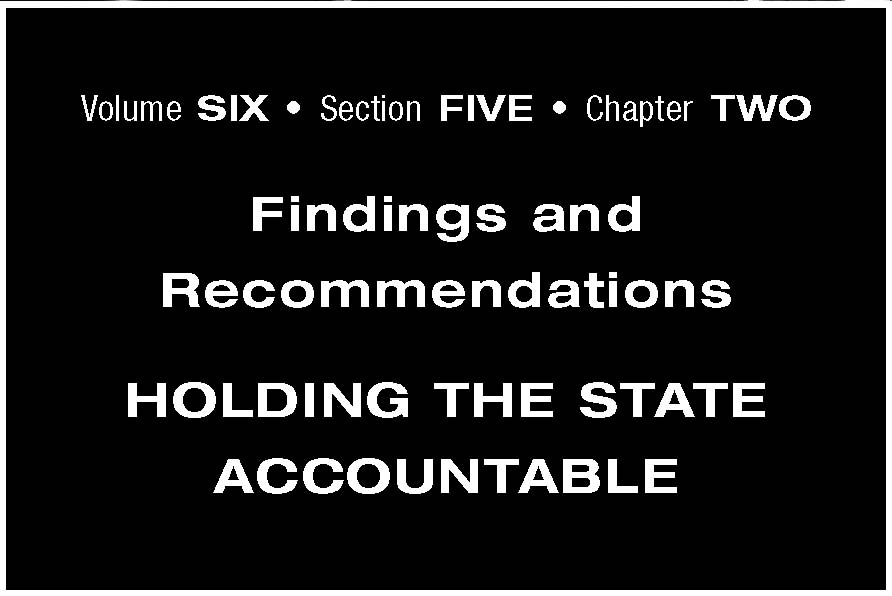 |
News | Sport | TV | Radio | Education | TV Licenses | Contact Us |
 |
News | Sport | TV | Radio | Education | TV Licenses | Contact Us |
TRC Final ReportPage Number (Original) 614 Paragraph Numbers 1 to 8 Volume 6 Section 5 Chapter 2 Subsection 1  Volume SIX Section FIVE Chapter T W O Holding the State Accountable1. In its five-volume Final Report, the Truth and Reconciliation Commission (the Commission) was guided by Section 4 of its enabling Act 2 1 in evaluating the roleplayed by those who were involved in the conflicts of the past. The relevant sections read as follows: The functions of the Commission shall be to achieve its objectives, and to that end it shall – (a) Facilitate and where necessary initiate or co-ordinate, enquiries into… iii) The identity of all persons, authorities, institutions and organizations involved in gross violations of human rights; iv) The question whether such violations were the result of deliberate planning on the part of the State or a former state or any of their organs or of any political organization, liberation movement or other -group or individual; and v) Accountability, political or otherwise, for any such violations. 2. Describing how findings were made, the Commission stated: … the Commission is of the view that gross violations of human rights were perpetrated in the conflicts of the mandate era. These include: The state and its security, intelligence and law-enforcement agencies, the SAP, the SADF and the NIS …22 3. The Commission wishes to restate its position in its Final Report that, whilst it has made adverse findings on the basis of the evidence it received, it remains a commission of inquiry and, as such, is not bound by the same rules of evidence as a court of law. The Commission based its findings on a balance of probabilities and its conclusions should not be interpreted as judicial findings of guilt but rather as findings of responsibility within the context of its enabling Act. 4. In making these findings, the Commission was guided in its deliberations by international humanitarian law and the Geneva Conventions. The Commission also endorsed the internationally accepted position that apartheid was a crime against humanity. 5. Whilst the Commission was obliged by its enabling act to evaluate the conduct of all those responsible for committing gross human rights violations, the Commission did not hold that all parties were equally responsible for the violations committed in the mandate period. Indeed, the evidence before the Commission has revealed that the former state was the major violator. 6. The Commission wishes to restate that a legally constituted and elected government is expected to act lawfully and in accordance with accepted international principles of humanitarian law. A state must be held to a higher standard of moral and political conduct than any other role player in a violent conflict. After all, a state has at its command powers, resources, privileges, obligations and responsibilities that liberation movements and other role players do not. 7. The Commission’s primary finding in its previous report was that:23 The predominant portion of gross violations of human rights was committed by the Former State through its security and law-enforcement agencies. Moreover, the South African State in the period from the late 1970’s to early 1 9 9 0 ’s became involved in activities of a criminal nature when, amongst other things, it knowingly planned, undertook, condoned and covered up the commission of unlawful acts, including the extra-judicial killings of political opponents and others, inside and outside South Africa. In pursuit of these unlawful activities, the State acted in collusion with certain other political groupings, most notably the Inkatha Freedom party (IFP). 8. The Commission made its findings at a time when the amnesty process had not yet been completed. The amnesty process is now complete and the Amnesty Committee has completed its re port .2 4 This chapter will show that amnesty decisions have tended to support the original findings of the Commission. In dealing with the findings and an analysis of the amnesty process, it is necessary to review how international humanitarian law has evolved to deal with conflicts and g ross human rights violations. 21 The Promotion of National Unity and Reconciliation Act No. 34 of 1995. 22 Volume Fi v e, Chapter Six, p. 2 0 9 . 23 Volume Fi v e, Chapter Six, p. 2 1 2 . 24 See Section One of this volume. |